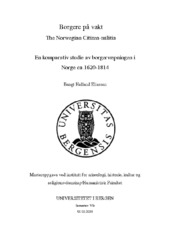Borgere på vakt: En komparativ studie av borgervæpningen i Norge ca. 1620-1814
Master thesis
Permanent lenke
https://hdl.handle.net/1956/17591Utgivelsesdato
2018-04-10Metadata
Vis full innførselSammendrag
The thesis is an attempt to analyse what, if any, kind of military experience the Norwegian citizen militia had. The objects of study are the cities of Trondheim, Bergen, Fredrikstad and Halden during the assigned period of 1620 up until 1814. The other two questions posed by the thesis are; in what manner was the citizen militia in these cities supposed to function based on the available source material, and did their geographical position and proximity to potential enemies affect the way they organised their training and what kind of focus they had? The thesis is structured so as to not only compare the cities with each other, but also to look at how things evolved over time in the span of the 15th century, and to compare the legislative texts of the 1600s with that of the early 1800s. The first half of the study presents the different cities and the legislative material assigned to their militias, indicating how they were supposed to organise the watch. It appears that despite the fact that the militia are presented as a local defence force in much of the research literature, throughout most of the 1600s the citizen militia in Trondheim and Bergen were largely intended to operate as a combination of police force and firefighters. Due to the lack of legislative texts available concerning Fredrikstad and Halden, the analysis regarding these cities is primarily based on scholarly historical presentations. Despite this, it appears that much the same is true for these eastern cities. By contrast, the ordinances of the early 1800s indicate that the Norwegian citizen militia was being reorganised to fit a military template, the focus shifting from law and order into weapons training, standardised uniforms and a detailed and well developed command structure. The second half compares the differences and similarities of the respective militias, finding that the general military experience of the citizenry of these cities was rather lacking, with the exception of Halden.
